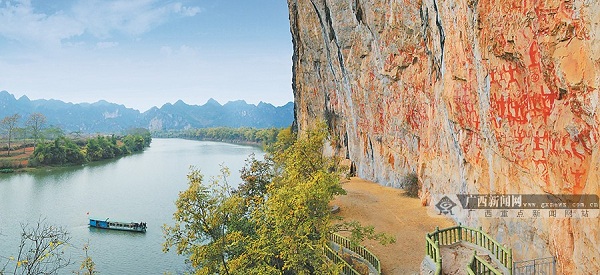Huashan Rock Art

Zuojiang Huashan Rock Art Cultural Landscape. [Photo/gxnews.com.cn]
Zuojiang Huashan Rock Art Cultural Landscape is located in Ningming county, Longzhou county, Fusui county, and Jiangzhou district of Guangxi Zhuang autonomous region. On July 15, 2016, it was added on UNESCO's World Heritage List during the world heritage committee's 40th session in Istanbul, Turkey.
With an area of 6,621 hectares, the cultural landscape includes 38 rock art sites and 105 meters of the Zuojiang River and Mingjiang River. The rock art is engraved on lime cliffs along the riverbanks of the two rivers, with a total of 109 paintings depicting 4,050 figures engraved by the ancient Zhuang people 2,000 years ago.
The huge red rock paintings recorded scenes of sacrifices in ancient times, as well as detailed the spiritual world and social development of the Luoyue people, the ancestors of the Zhuang in Guangxi. Huashan rock arts possess outstanding value in cultural anthropology, national history, and painting and artistic creation.
Zuojiang Huashan rock arts are one of the largest rock painting groups that have been discovered in the world so far. It is an important witness to the history of Luoyue culture and a cultural treasure shared by the Chinese nation and the whole world.
The Zuojiang Huashan Rock Art Cultural Landscape is a set of cultural landscape units and unique image expression systems that are carefully constructed with rock paintings as the core. It reflects prosperous sacrificial traditions, as well as a unique way to communicate between man and nature that are formed by dance rituals and rock paintings.














